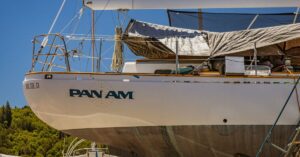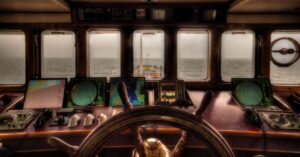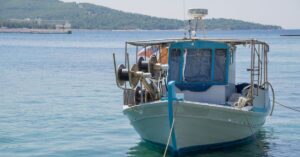When boating during the twilight hours or after sunset, ensuring your vessel’s and fellow boaters’ safety becomes paramount. Navigation lights are crucial in alerting other watercraft of your boat’s presence and indicating its direction of travel. In this blog post, we will explore the importance of navigation lights, their standard configurations, legal requirements, and tips for maximizing their effectiveness.
The Role of Boat Navigation Lights
1. Safety
Navigation lights are crucial in ensuring the safety of boats and other watercraft. They provide a means for vessels to communicate their position, direction, and status to other boats in the vicinity, especially during reduced visibility at night or in adverse weather conditions.
2. Collision Avoidance
By displaying the appropriate navigation lights, boats can maintain their visibility to other vessels, helping to prevent collisions and accidents on the water. When boats are approaching each other, understanding the respective navigation light patterns allows for better prediction of their paths and intentions.
3. International Regulations
The use of navigation lights is mandated by international regulations, such as the International Regulations for Preventing Collisions at Sea (COLREGS). These regulations define specific light configurations and colors for different types of boats and activities, ensuring consistent and standardized practices across the maritime community.
4. Nighttime and limited visibility operations
Navigation lights are essential during nighttime operations when visibility is limited. They enable boaters to navigate safely, maintain course, and identify other vessels, buoys, or navigational aids.
5. Distress signals
In certain situations, navigation lights can also serve as distress signals. By altering their light patterns or displaying specific distress signals, boaters can indicate their need to assist nearby vessels or search and rescue teams.
6. Legal compliance
Boaters are legally required to have functioning navigation lights on their vessels when operating during restricted visibility conditions or between sunset and sunrise. Failure to comply with these regulations may lead to penalties or the risk of accidents and collisions.
Types of Navigation Lights
The standard boat navigation lights include the following types of lights:
1. Steaming Light
A steaming light is a white light positioned on the boat’s centerline and angled forward. It is commonly used in boating and is required by international regulations for powered vessels operating at night or in poor visibility conditions. The purpose of the steaming light is to indicate the presence and direction of a powered vessel, alerting other boats to its presence and forward movement of travel.
The steaming light is typically mounted on the mast of the boat. But it can also be installed on a fixed structure on the centerline. It is important to note that the steaming light is used with other navigation lights, such as the sidelights (port and starboard lights), stern light, and masthead light, to provide a comprehensive lighting system that helps ensure safe navigation and avoid collisions.
When using the steaming light, it is essential to comply with the regulations regarding its placement, orientation, and visibility range. These regulations may vary depending on the size and type of the vessel and the maritime area in which it operates.
2. Port and starboard lights
Port and starboard lights, also known as sidelights, are navigation lights mounted on a boat’s port (left) and starboard (right) sides. International regulations require them and are usually displayed in conjunction with other navigation lights, such as the steaming light, stern light, and masthead light, to ensure safe navigation and avoid collisions.
The port light is red, and the starboard light is green. The purpose of these lights is to indicate the direction of the boat’s travel and its relative position to other boats. When approaching another boat, the colors of the sidelights can help determine which way it is moving.
The sidelights must be visible to other boats from a minimum distance of 1 nautical mile (1.85 km) in restricted visibility conditions. They are mounted at or near the boat’s bow, with the green light on the starboard side and the red light on the port side, and they must be displayed so that any other part of the boat does not obstruct them.
Always have the port and starboard lights on when the boat is underway at night or in conditions of limited visibility. This will help other boats determine the direction of approach and avoid collisions. The sidelights are among the essential navigation lights required for ensuring safe boat operation and navigation.
3. Stern light
A stern light refers to a light displayed on a ship or boat’s stern (rear) area. The purpose of the stern light is to provide visibility to other vessels approaching from behind. It is typically positioned as near as possible to the stern and shines in an arc of 135 degrees, centered on dead astern3. The stern light helps indicate the presence and direction of a vessel, especially during night navigation or limited visibility conditions.
Following international regulations, the stern light must be a white light showing over an unbroken arc of 135 degrees, centered on dead astern. This light should be visible from at least two nautical miles (about 3.7 kilometers) in optimal visibility conditions.
The stern light is often combined with other navigation lights, such as sidelights (port and starboard lights) and masthead lights, to ensure the vessel’s visibility from all directions. Together, these lights help provide a comprehensive lighting system that aids in safe navigation and collision avoidance at sea. Please note that the color of a boat’s stern light is not specifically regulated, but the most common color used is red, which is considered highly visible.
4. Masthead Light
A masthead light is a white light placed over a vessel’s forward and aft centerline, typically positioned on the mast. It is a type of navigation light used to indicate the presence and position of a vessel at night or in conditions of limited visibility. The masthead light emits an unbroken white light over an arc of the horizon spanning 225 degrees. This light is fixed so that it shines from right ahead to 22.5 degrees abaft the beam on either side of the vessel.
The masthead light is an essential component of a vessel’s lighting system, often referred to as a steaming light. When displayed, it informs other vessels about the vessel’s heading and position on the water. It is commonly used when a boat operates under motor power at night.
The positioning of the masthead light is not specifically regulated. It can vary depending on the size and type of the vessel. In some cases, it is mounted at the top of the mast. In other cases, it may be placed on the mast above or behind the bridge to avoid causing undue glare.
It’s worth noting that a masthead light should not be confused with a masthead anchor light, a separate white light located at the masthead. The masthead anchor light is used to indicate that a vessel is anchored.
5. All-around White light
An all-around light is a navigation light displayed on boats to indicate their position and movement in all directions. It’s a white light that can be seen from any direction. It is used to signal the presence of a vessel in low light or limited visibility conditions.
All-around lights are sometimes called anchor lights because they are also used to mark a boat’s position when anchored. In this case, the all-around light must be displayed at the vessel’s highest point and shine unobstructed over an arc of 360 degrees.
All-round lights not used as anchor lights must comply with specific international regulations. These lights must be visible from any point of view from a minimum distance of two nautical miles in optimal visibility conditions. They can be used instead of, or in addition to, other navigation lights, such as the masthead light, to indicate the vessel’s position.
All-round lights can be located on the boat’s mast, on a specialized pole or fixture, or at the boat’s cabin or other elevated structures. They can be steady or flashing, depending on the type of vessel and its intended use.
Legal Requirements for Navigation Lights
Typically, boats under power must display navigation lights from sunset to sunrise and during periods of reduced visibility. Sailboats underway may also need to display navigation lights. While at anchor, they usually only need to exhibit an anchor light.
For powerboats under 12 meters (39.4 feet) in length, the following navigation lights are typically required:
- Sidelights: These lights are red on the port (left) side and green on the starboard (right) side of the boat and must be visible for one nautical mile. They cover an arc of 112.5 degrees.
- Stern light: This white light is located at the stern (back) of the boat. And it must be visible for two nautical miles.
In addition, sailboats and powerboats under 20 meters (65.7 feet) may have the option to use a tricolor light or a bi-color light combined with a stern light as a substitute for separate sidelights and stern light.
It is important to note that these requirements may vary depending on the country or jurisdiction in which the boat is operated. It is always advisable to consult the specific regulations of the relevant authority to ensure compliance with navigation light requirements for your particular area.
Navigation Light Tips and Best Practices
Regarding maintaining navigation lights on boats, there are several tips and best practices to follow. Here are some recommendations:
1. Regular Cleaning
Clean the contacts of both the bulb and the fixture regularly. To clean the contacts, you can use fine sandpaper wrapped around a dowel or a pen eraser. This will help ensure a good electrical connection and prevent corrosion.
2. Apply Dielectric Grease
After cleaning the contacts, apply a thin coat of dielectric grease. This grease helps to prevent corrosion and moisture ingress, preserving the functionality of the lights.
3. Check for Corrosion
Inspect the wiring terminals and connections for any signs of corrosion. Corrosion can affect the electrical conductivity and performance of the lights. So, clean off any corrosion and ensure a tight mechanical fit.
4. Regularly Check and Replace Faulty Bulbs
If you notice any navigation lights not functioning properly, promptly replace the faulty bulbs with new ones. Regularly inspecting and replacing bulbs as needed will help ensure optimal visibility and compliance with navigation light requirements.
5. Follow Manufacturer Guidelines
Consult the manufacturer’s guidelines or user manual for specific maintenance instructions for your navigation lights. Following the manufacturer’s recommendations will help ensure proper maintenance and longevity of the lights.
Conclusion
Navigation lights are essential for safe boating, enabling effective communication between vessels and reducing the risk of accidents. By understanding the standardized configurations, adhering to legal requirements, and following best practices for maintenance and visibility, you can enhance the safety of your boat and promote a secure environment for all boaters.
Remember, navigation lights should be considered a priority component of your boat’s equipment. Ensuring that others can easily see and interpret your vessel. With proper navigation light usage, you can confidently navigate the darkness. Enjoy your boating adventures while promoting a safe and enjoyable experience for everyone on the water.
Reference






